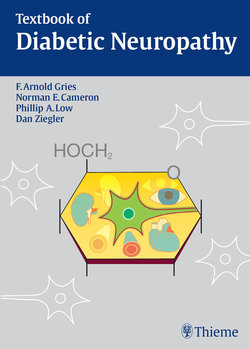Читать книгу Diabetic Neuropathy - Friedrich A. Gries - Страница 4
На сайте Литреса книга снята с продажи.
ОглавлениеPreface
It has long been known that diabetics are prone to characteristic diseases of the kidneys (P. Kimmelstiel and C. Wilson 1936), eyes (E. Jaeger 1853), and nerves (J. Rollo 1798). However, it wasn't until insulin therapy became established and large numbers of patients with long-term diabetes were examined that the syndrome-like character of these complications became recognized in the mid-20th century. Because the incidence of complications rises with the duration of the diabetes, it was once common to speak in terms of a “late diabetic syndrome.” Today the preferred term is “chronic diabetic complications.” These complications basically determine the quality of life and life expectancy of persons with diabetes. Their prevention is an important focal point of modern diabetes management.
Chronic diabetic complications are firmly entrenched in the consciousness of patients and their therapeutic teams. In the past, diabetic neuropathy (DNP) was usually relegated to the role of a neglected stepsister. But this attitude in no way reflects its impact on quality of life, problems of diabetes management, sequelae such as oligosymptomatic myocardial ischemia and diabetic foot syndrome, disease costs, or the prognosis for survival. One reason for the tendency to underestimate DNP may be that the functional disturbances of the nervous system can run a subclinical course for some time. The patient has no obvious distress, and the physician finds evidence of the neuropathy only by conducting specific tests. The physician's efforts may lack focus due to the absence of a positive nosologic definition and generally accepted diagnostic criteria and standards, and because the clinical manifestations of DNP are so diverse. Finally, therapeutic options for DNP were, until recently, unsatisfactory.
For many years, then, DNP was not a matter of serious concern in any of the clinical or theoretical biomedical disciplines. This changed only during the last three decades. In 1978, the first international symposium was held dealing with autonomic DNP. The proceedings of that conference were published by Thieme Verlag (Gries et al. Aspects of Autonomic Neuropathy. Stuttgart-New York: Thieme; 1980). Within a decade, an international group formed and began to organize and publish symposia within the framework of the International Diabetes Federation Congresses, which are held every three years. A special expression of the growing interest in DNP was the founding of NEURODIAB, the Diabetic Neuropathy Study Group of the European Association for the Study of Diabetes (EASD) in 1989. Since that time, this group has staged annual meetings at a high scientific level, attended by scientists from all over the world. This study group may well be the most effective channel for the rapid, critically attended exchange of information on advances in DNP research.
Scientific conferences are held mainly for the purpose of discussing new research results. Accordingly, the publications stemming from these conferences are geared toward the research interests of the authors. Information on state-of-the-art knowledge and techniques is presented in a highly selective way.
Our goal is to present a systematic review that covers both the physiology of the nervous system and the pathology and pathophysiology of the various forms of DNP. Given the past inadequacies of pharmacotherapy, we explore the pathology and pathophysiology of DNP from various aspects, since they provide the basis for the development and evaluation of medical therapies. Against this background, special emphasis is placed upon the clinical presentation of DNP. Finally, we address the socioeconomic aspects of DNP and offer thoughts on a structured approach to treatment. This chapter includes guidelines for the diagnosis and outpatient management of diabetic peripheral neuropathy. They are consensus guidelines. After the manuscript was completed, evidence-based guidelines on sensorimotor and autonomic DNP were issued by the German Diabetes Association in cooperation with various professional societies. They include recommendations on the responsibilities of the various care levels (general practitioner, internist, diabetologist, neurologist, hospital). Unfortunately, these guidelines could not be incorporated into the present work.
All the chapters conclude with an extensive reference list for further reading, although we did not attempt to make the list complete. We beg the indulgence of readers who find no mention of their own important contributions. We also admit that our ideal concepts for the book have not been perfectly realized, and therefore we are grateful for any constructive comments or criticisms.
The preparation of this book demanded a great deal of effort from many distinguished experts in their fields. We gratefully acknowledge the team spirit of our authors and their outstanding contributions.
We express thanks to our publisher, especially Clifford Bergman. M.D. and Mr. Gert Krüger and their teams, for their support and dedication in the editing and publication of this book.
Fall 2002
F. Arnold Gries
Norman E. Cameron
Phillip A. Low
Dan Ziegler
